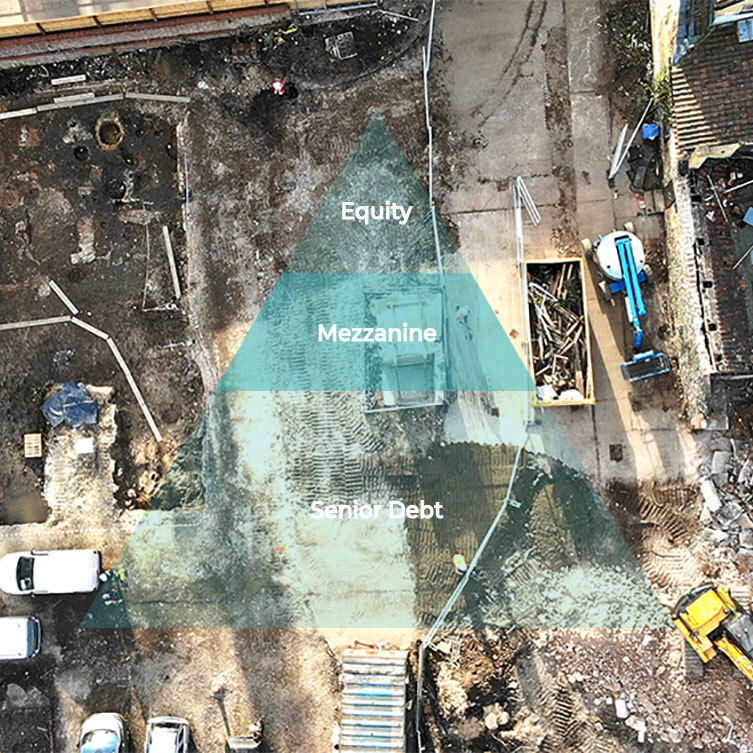
Choosing finance with confidence
Skip to find out more about:

What is development finance?
Development loans have the interest paid up front or 'rolled up.’
The main consideration for this type of property development loan is that you'll need to have planning permission in place already or agree on the deal subject to securing planning permission.
You'll also have to have a good base of assets to offer as security and make sure that it's a financially feasible project.
The feasibility of your project will be decided based on the estimated time that it will take to finish your development, a breakdown of the costs that will be involved and a good end value estimate.
Once this is sorted, you’ll typically be able to borrow about 50%-60% of the purchase price depending on the scale of your project.
What are the current costs, fees and interest rates of development finance?
| Lender Category | Purchase Costs | Dev. Costs | Interest | Fees | Comments |
|---|---|---|---|---|---|
| Mainstream Banks | Up to 65%, only if work to start within 6 months | Up to 65%, maximum 50-55% of GDV + maximum of 60% LTC | 4.5-6% | Generally 1.5% but some have the same exit fee | Relationship banking and best pricing, but can be slow + restrictive on LTV - all clients go in first |
| Challenger Banks | Up to 75% | Up to 85%, maximum 60% of GDV - maximum of 90% of total costs | 6-10% pa | 2% to 4% plus legals and valuation | Faster processing; some dislike new build |
| Specialist Lenders | 65-75%, may go up to 90% of purchase | Up to 100%, maximum 65/70% of GDV - maximum of 90% of total costs | 7-12% pa | 2% to 4% plus legals and valuation | Best deals over £1m + need assets to make personal guarantee stack up |
Again you’ll need to be able to either sell your property/ies or be able to refinance them.
These loans are typically an option for more experienced developers, but don’t get discouraged.
If you yourself don’t have much hands-on expertise, you may be able to secure one of these property development loans based on the expertise and track record of the people that you take on, e.g your builders, architects, etc.
If you want to pursue this financing option in that instance, you’d probably want to find a highly experienced property development finance broker who has access to a wide variety of lenders from various different backgrounds - lenders who are equally happy to invest in any different type of property project regardless of the size or scale.

What are bridging loans?
Using a bridging loan for property purchase, this is a form of short term finance for securing a loan quickly.
For example, if you’re on the lookout for great new properties to buy, but you’re still waiting for one of your current properties to sell, you could use this type of loan to ‘bridge the gap’ between purchase and sale, so you don’t have to burn a hole in your pocket or see your dream property in another developer’s hands.
Your bridging lender will ask to see proof to ensure that this loan will actually be used for the short term as it’s meant to be, and you’ll have to sell or refinance your property in the very near future.
Bridging loans for property development are a useful financing strategy when high street lenders and banks might be more cautious to lend other types of mortgages.
What are the current costs, fees and interest rates of bridging loans?
| Lender Category | Purchase/ Refinance | Interest | Fees | Comments |
|---|---|---|---|---|
| Mainstream Banks | Very few offer bridging - Max 50% LTV | Whatever they want but usually 7-10% | Start at 1.5-2.5% | High street banks are not interested in bridging |
| Challenger Banks | 80% but best rates at 65% and under - will go to 100% if other protection offered | Starting at 0.5% pcm going up to 1.5% pcm | Starting at 1% but usually 2-3% | Fast and easy to use. Great to secure property fast |
| Specialist Lenders | 80% but best rates at 65% and under - will go to 100% if other security offered | Starting at 0.5% pcm going up to 1.5% pcm | Starting at 1% but usually 2-3% | Fast and easy to use. Great to secure property fast |
But you’ll have to remember that this type of loan is secured against your property - which makes it even more necessary to repay in time, otherwise you’ll lose your property.
You can also pay steeply for this type of property development loan, as the interest rates are higher than other types of mortgages.

What is a buy to let (BTL) mortgage?
A buy to let mortgage enables you to purchase a property and rent it out, thus bringing in an income monthly or for you later in life.
- No minimum income requirement lenders
- Interest Only
- Repayment
If you want to benefit from this type of loan you’ll need to have a good credit score and earn more than £20,000 per annum.
These are known for being pricey enterprises - with higher fees and higher interest rates
Interest only
You only have to pay the interest on your loan on a monthly basis, but you’ll still have to pay the full original loan cost at the end of your mortgage term.
The minimum deposit for a buy to let can be anywhere from 20-40% of the property price, but to be eligible for the majority of lenders we would recommend at least a 25% deposit.
The amount you can borrow will be dependent on the amount of rental income you can make rather than your own personal income. Lenders use specialist stress tests to provide you with the maximum loan available based on the rental income potentially achievable on the property.
This is the most common option for people who are entering the buy to let world who want to benefit from the rental income now and on a monthly basis.
Capital repayment
You can have a buy to let mortgage on a repayment basis, this then offers the protection of knowing the debt will be repaid at the end of the term. The monthly payment will be higher than interest only though, as you are repaying the capital debt as well as servicing the interest.
This is the most common option for people who are entering the buy to let world to benefit late on in life. I.e retirement.
The deposit would be the same as an interest only mortgage and your borrowing capacity will be calculated in the same way.
What are the current costs, fees and interest rates of BTL mortgages?
| Lender Category | Purchase/ Refinance | Interest | Fees | Comments |
|---|---|---|---|---|
| Mainstream Banks | Up to 80%. Best rates at 70% and under | Lowest B2C rate 1.72-4% | Generally £995 but up to 1.5% - which can be added to the overall loan. | Following PRA announcement, stress testing now at 5.5% x 145% (Ltd company probably way forward as lenders use 125%) |
| Challenger Banks | Up to 85%. Best rates at 75% and under | Starting at 1.35% up to 6% | Generally £995 but up to 1.5% - which can be added to the overall loan. | Following PRA announcement, stress testing now at 5.5% x 145% (Ltd company probably way forward as lenders use 125%) |
| Specialist Lenders | Up to 85%. Best rates at 75% and under | Starting at 1.19% up to 6% | Generally £995 but up to 1.5% - which can be added to the overall loan. | Following PRA announcement, stress testing now at 5.5% x 145% (Ltd company probably way forward as lenders use 125%) |

What are commercial mortgages?
Commercial term mortgages will usually grant you between 60-75% of what the property is worth.
Like with buy to let properties, the amount that you’ll be able to borrow will be dictated by the amount of rental income that you expect to make off your property.
Using a commercial term mortgage might mean that it’s harder for you to find fixed rates, and these mortgages usually have higher interest rates than general residential mortgages, as these types of investments are seen as risky by the banks.
The interest that your mortgage racks up will, however, be tax deductible.
Like with development loans, lenders like to see that you’ve got some property development experience, so if you’re a relatively recent trader they’re likely to want to see personal guarantees.
What are the current costs, fees and interest rates of commercial mortgages?
| Lender Category | Purchase/ Refinance | Interest | Fees | Comments |
|---|---|---|---|---|
| Mainstream Banks | 60%. Can go to 70-75%, if strong sector (not property related) | Can start at 2% above base up to 6% | 1.5% arrangement fee is standard | Long leases to be in place prior to completion. Restrictive criteria |
| Challenger Banks | 75% | Starting at 3.5% up to 7% | From £999 to 2.5% | Easier to deal with but rates + fees can go very high |
| Specialist Lenders | 75% | Starting at 3.5% up to 7% | From £999 to 2.5% | Easier to deal with but rates + fees can go very high |

Can you get a mortgage for land?
Residential land development loans are a subset of development loans which can be used to fund the construction of a residential scheme.
The loan is offered as a short term option on an interest only basis, with the construction funds released in stages.
You’ll need to prove you have a solid exit strategy in advance, which would usually include either the sale of your development or a remortgage.
You’ll usually be offered between 70-75% of the funds you need to acquire your site, as well as 100% of the staged development funds. Once your loan term ends, the lender will expect you to pay up the debt in full.
It’s likely that your lender will carry out an inspection of your development site before they release your funds, in order to ensure that the project is on track, and they’ll charge a fee every time they do so.
Providers often carry out a site inspection before each instalment is issued to make sure the project is on track, and will charge a fee each time they attend the development.

What is mezzanine finance?
You can use mezzanine finance for property development as a type of ‘top up loan’ to top up the gap between the developer’s affordable deposit and the loan from the senior debt lender.
It’s a hybrid of debt and equity financing.
It’s a type of property development loan where your debt becomes an equity share once the time frame you’ve predetermined with your lender has passed.
So if you can’t pay back your funding, they’ll get a share of the equity or your profits instead, on top of your interest payments - effectively equity acts as the lender’s protection instead of any other assets.
Mezzanine finance is a very complex option for a property development loan, with the specifics varying between developers.
It’s a flexible funding option that’s great for getting long term projects off the ground, but be warned - it’s known for being a very expensive method of finance.
